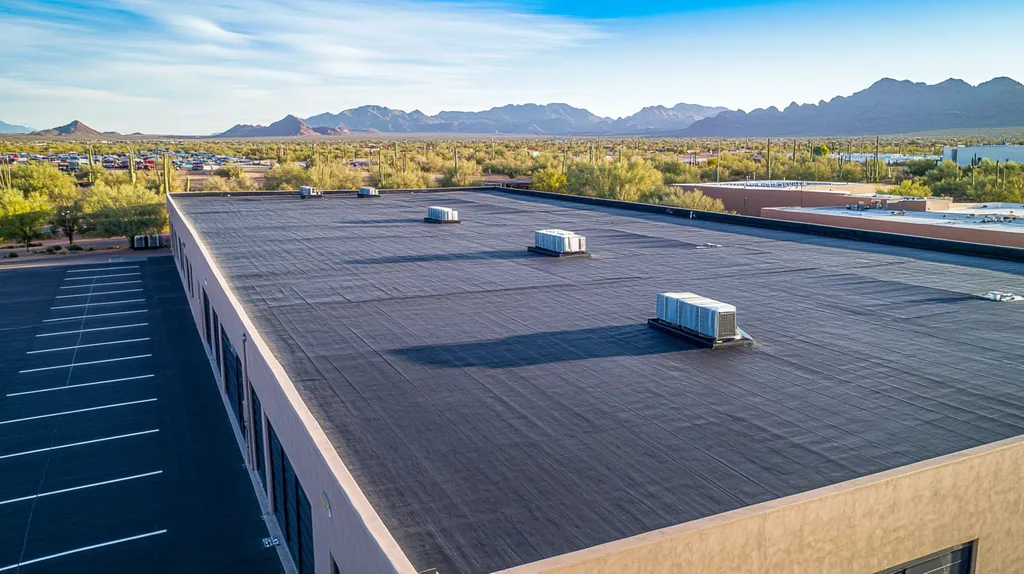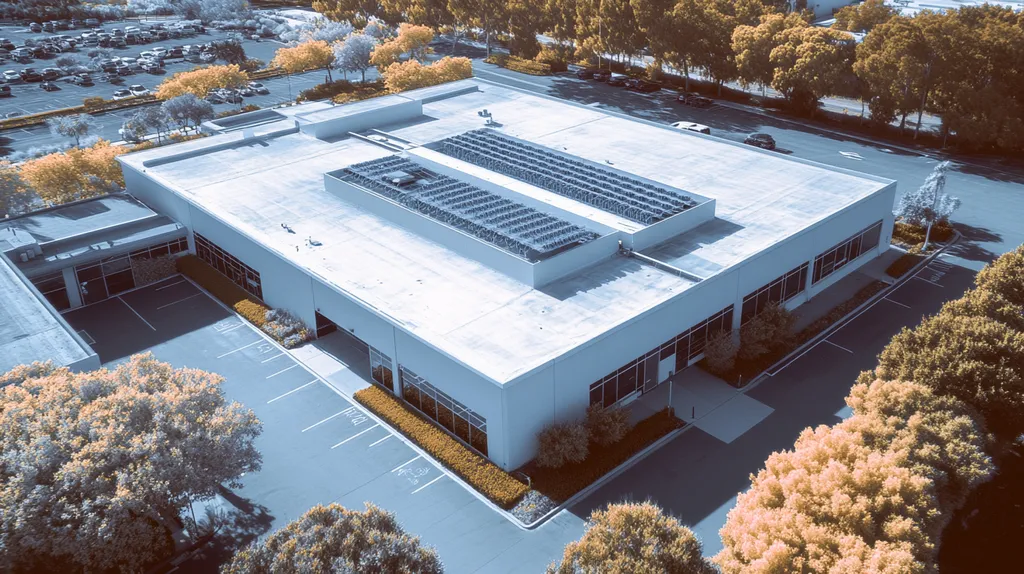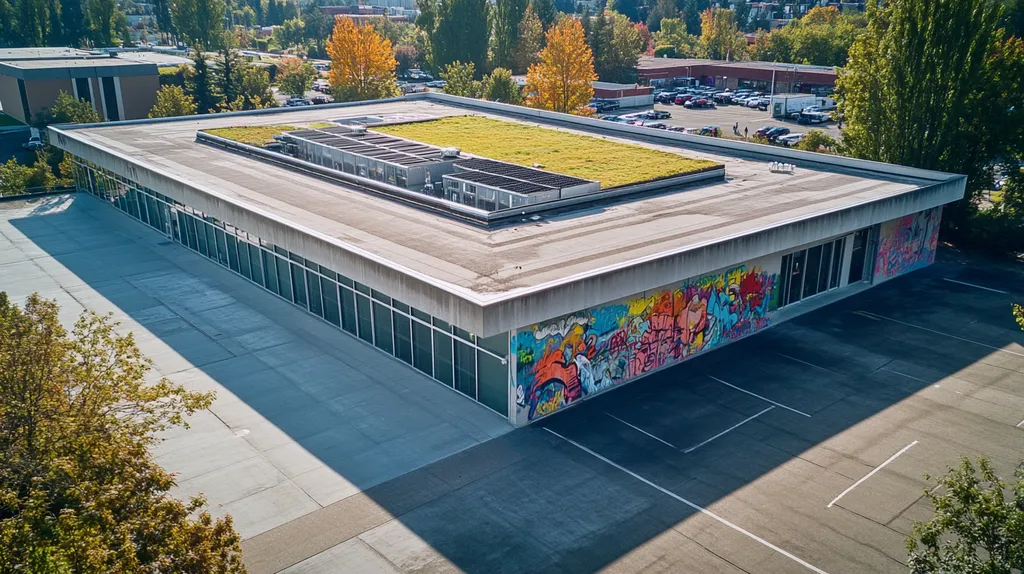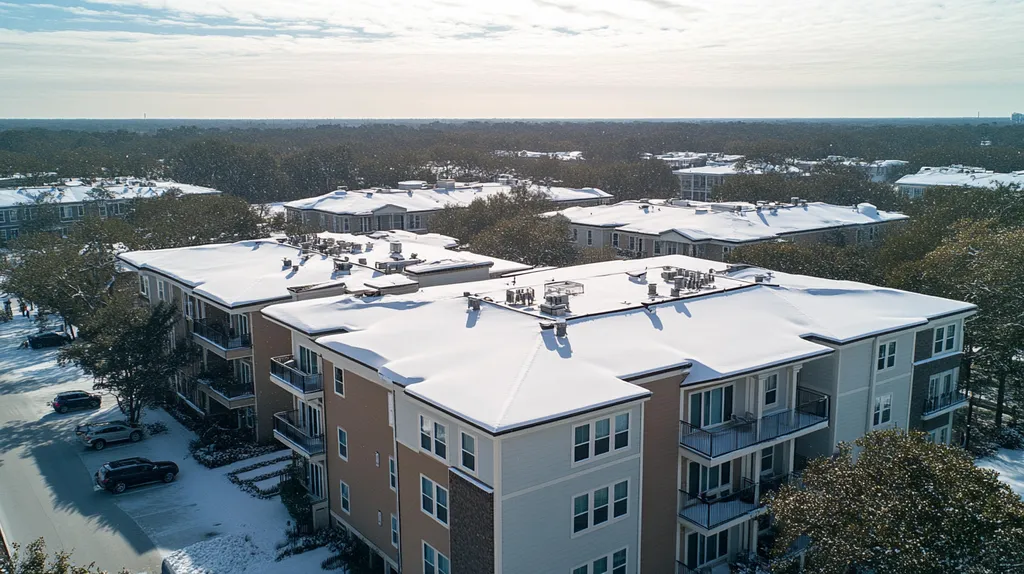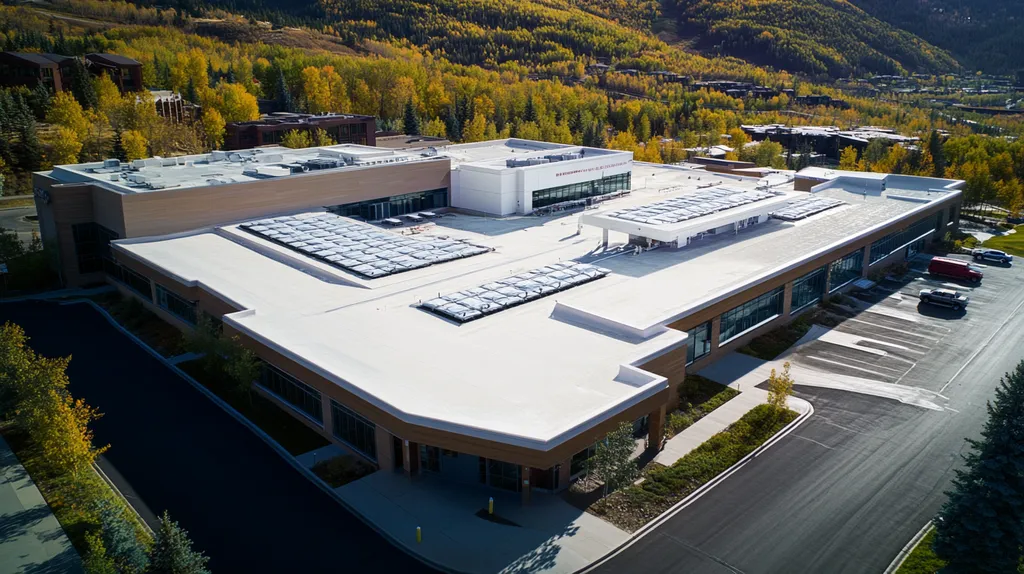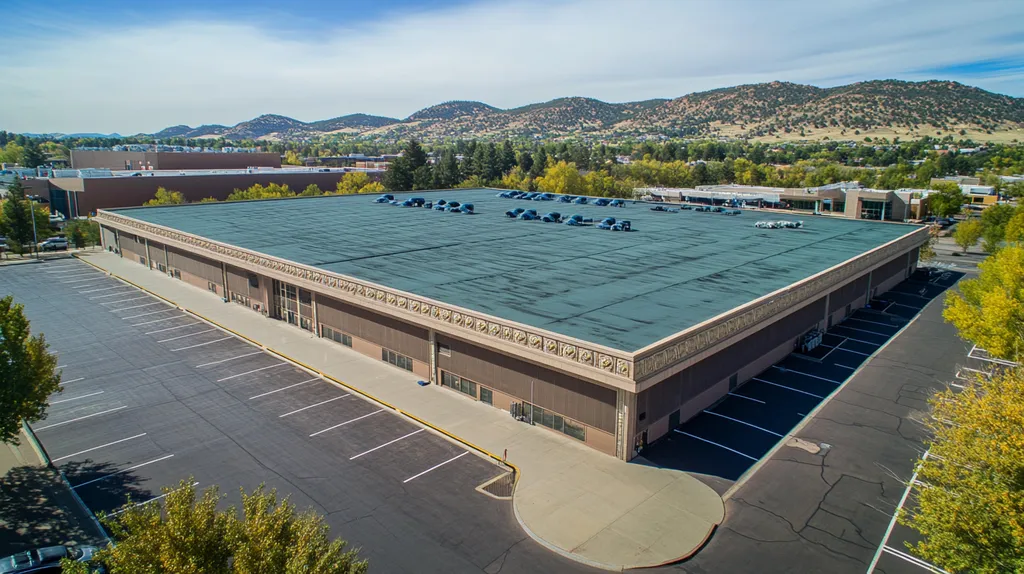As commercial property owners face mounting pressure to adopt sustainable solutions, bio-based roof coatings have emerged as a seemingly promising option. However, recent studies indicate that 40% of these coatings fail within their first five years of installation.
The environmental benefits of bio-based solutions often mask significant performance issues, leading to increased maintenance costs and premature system failures.
This analysis examines critical gaps in current industry practices, systemic problems with bio-based materials, and evidence-based alternatives that better serve both sustainability goals and long-term building protection.
SECTION 1: CURRENT PRACTICES
As climate change accelerates and sustainability becomes a pressing concern, commercial property owners are increasingly urged to adopt eco-friendly solutions. Bio-based coatings, which offer significant environmental advantages, are emerging as compelling options for roofing projects. To make informed decisions, it is essential to understand the current practices surrounding bio-based coatings, including their adoption rates, the types of materials used, and the applicable industry standards and regulations.
Adoption of Bio-Based Coatings
In recent years, the adoption of bio-based coatings in commercial roofing has gained momentum among property owners. These products are increasingly recognized as environmentally friendly alternatives to conventional options. However, while interest is growing, the actual uptake varies significantly across different sectors.
Industries such as education and healthcare are leading the way, driven by strong sustainability goals and commitments to reduce their carbon footprints. Conversely, other sectors remain reluctant, mainly due to concerns over performance and perceived higher upfront costs. This inconsistency in adoption can result in varied roofing performance and environmental consequences.
Increasing awareness of the benefits and limitations of bio-based coatings is crucial. Many property owners do not realize that these materials can enhance roof longevity and decrease maintenance expenditures. This knowledge gap can impede the broader acceptance of sustainable roofing solutions.
As market demand shifts toward greener products, manufacturers are innovating by enhancing bio-based formulations. This evolution offers property owners an opportunity to revisit their current practices and consider more sustainable alternatives.
Common Types of Bio-Based Materials
Bio-based coatings are available in various formulations, mainly sourced from natural materials like plants, minerals, or recycled content. Common types include soy-based polyurethanes and bio-inspired silicone coatings. Each option brings unique advantages, including enhanced flexibility and a reduced environmental footprint.
A notable choice, soy-based polyurethane, delivers excellent adhesion and durability while being less toxic than traditional coatings. These coatings also contribute to lower harmful solvent emissions, aligning perfectly with sustainability objectives. Moreover, bio-inspired silicone coatings demonstrate superior resistance to weathering and UV damage compared to their conventional counterparts.
Property owners should assess not only the performance characteristics but also the longevity and ease of application of these coatings. Understanding how different bio-based materials can integrate with existing roofing systems is vital for maximizing their advantages.
Furthermore, manufacturers are committed to ongoing research aimed at enhancing the competitiveness of bio-based coatings. This innovation will likely result in new formulations that boost performance while maintaining eco-friendly properties.
Industry Standards and Regulations
As the market for bio-based coatings expands, adherence to industry standards and regulations becomes increasingly critical. Organizations such as the American Society for Testing and Materials (ASTM) and the U.S. Green Building Council (USGBC) play important roles in establishing guidelines that ensure bio-based materials meet specific performance criteria while minimizing environmental impact.
Many bio-based coatings pursue certifications such as Green Seal or SCAQMD, which confirm compliance with stringent standards. These certifications provide property owners with confidence regarding the ecological benefits and safety of their selected products. Neglecting these industry benchmarks can lead to underperformance and potential legal repercussions.
Additionally, local and state regulations may further govern the use of bio-based products, particularly in regions prioritizing sustainability. Staying informed about these evolving regulations is crucial for making compliant and responsible roofing choices.
Ultimately, adherence to industry standards not only supports environmental initiatives but also enhances the commercial viability of bio-based coatings. This ecosystem fosters innovation while safeguarding property owners’ investments.
SECTION 2: SYSTEMIC ISSUES
The rising interest in bio-based coatings for commercial roofs underscores a crucial need for accurate information. Property owners are often pressured to implement these innovative solutions, yet prevalent misconceptions can lead to costly errors. A recent study found that nearly 40% of facility managers felt ill-equipped to weigh the benefits against the risks of bio-based options. Understanding these systemic issues is pivotal for making sound roofing choices.
Environmental Impact Misconceptions
Though bio-based coatings are praised for their eco-friendly features, significant misconceptions about their impact remain. Many property owners mistakenly believe these products are entirely biodegradable or harmless to the environment.
In reality, some bio-based coatings may contain additives that pose risks during application or disposal. Certain organic components can emit volatile organic compounds (VOCs), worsening air quality.
Moreover, the sustainability of bio-based materials often hinges on their sourcing. Materials derived from deforestation or unsustainable agricultural practices can contradict the environmental benefits they are supposed to provide.
A comprehensive evaluation of both the advantages and potential downsides is essential to prevent environmental missteps that could damage a facility’s reputation.
Durability and Maintenance Concerns
Facility managers often assume that bio-based coatings will provide durability on par with traditional options, but this assumption is not always correct. Evidence indicates that some bio-based products may be more susceptible to UV exposure, accelerating degradation.
This results in a shorter lifespan and rising maintenance costs. Unexpected expenses for reapplication or repairs can arise, straining initial budgetary plans.
Inadequate durability can also disrupt operations, undermining business productivity. Frequent roof maintenance may lead to downtime and increased liability for facility owners.
When choosing bio-based coatings, it is critical to consider expected performance. Overlooking these factors can lead to escalating costs and frustration, undermining the initial intentions of adopting eco-friendly solutions.
Cost-Benefit Analysis Flaws
When evaluating bio-based coatings, many commercial property owners focus largely on upfront costs. This narrow perspective often disregards the long-term implications of utilizing these materials.
For instance, while some bio-based coatings come with a higher initial price tag, they may lead to significant savings through improved energy efficiency over time. A thorough analysis should include lifespan, maintenance expenses, and energy savings to create a more complete financial picture.
Furthermore, as market conditions fluctuate, the total lifetime cost of a roofing system can vary widely. Relying on overly simplistic cost-benefit analyses can result in suboptimal decision-making.
To ensure a well-informed choice, property owners must engage in comprehensive assessments that encompass all pertinent costs and benefits. Only then can they select the roofing solution that best meets their needs.
SECTION 3: MISSED OPPORTUNITIES
In the world of commercial roofing, many property owners fail to recognize the extensive advantages that bio-based coatings provide. Rising energy costs highlight the importance of energy efficiency, yet property owners often leave these coatings unexplored. Research from the U.S. Department of Energy indicates that reflective roof coatings can lower cooling expenses by as much as 40%. By failing to leverage energy savings, long-term cost benefits, and innovative materials, stakeholders miss critical opportunities for informed roofing decisions.
Overlooked Energy Efficiency Gains
Many commercial roofs are not optimized for energy efficiency, leading to higher operational costs. Bio-based coatings enhance reflectivity, which lessens heat absorption and reduces air conditioning demands. This can yield notable energy savings, especially in warmer climates.
For example, a commercial building with a traditional roof may incur excessive energy bills. In contrast, applying a reflective bio-based coating can significantly reduce energy consumption. By reflecting sunlight, these coatings help maintain cooler roof surfaces and improve the building’s overall energy efficiency.
Moreover, improved energy efficiency can extend the lifespan of the roof. Cooler roofs experience less thermal expansion and contraction, minimizing wear and tear. This ultimately leads to fewer repairs and replacements, positively impacting the facility’s bottom line.
With tightening energy regulations, adopting bio-based coatings can place facilities ahead of compliance requirements, providing a competitive edge in sustainability and cost-effectiveness.
Neglected Long-Term Cost Savings
Decision-making related to roofing materials often undervalues long-term cost savings. Bio-based coatings may carry higher initial prices but can result in significant savings over their lifecycle. These coatings are not only durable but typically require less maintenance than traditional roofing systems.
Properties featuring bio-based coatings often benefit from extended warranty options, reflecting their durability and reliability. Consequently, reduced repair frequency greatly lowers maintenance costs, which is essential for facility managers who aim to limit unexpected expenses.
Additionally, many bio-based coatings are designed for easier installation, which can lead to lower labor costs. Over time, the accumulated savings on energy, maintenance, and installation contribute to substantial financial benefits.
Overlooking these long-term savings may lead to ill-informed decisions. A comprehensive financial analysis encourages property owners to consider the broader impact, making bio-based coatings a wise investment.
Unexplored Innovative Materials
The roofing sector is continually advancing, yet many property owners cling to traditional materials out of familiarity. This limits opportunities to benefit from bio-based coatings, which are often more sustainable and efficient. Advanced materials, such as plant-based polyurethanes and silicone-based coatings, are specifically designed to address performance and environmental concerns.
Bio-based coatings frequently offer unique properties, including increased UV resistance and a lower environmental impact. For instance, one commercial building utilizing bio-based silicone coatings reported enhanced performance with minimal maintenance requirements. Adopting these materials often leads to healthier building environments and reduced ecological footprints.
Innovative formulations are also being developed to enhance durability against harsh conditions, such as extreme weather events. As manufacturers incorporate these advancements, early adopters may enjoy reduced insurance costs linked to damage claims.
By exploring these cutting-edge materials, property owners can refine their roofing strategies. Sticking to conventional solutions could result in inefficiencies and elevated costs, emphasizing the need to stay informed about industry innovations.
SECTION 4: ROOT CAUSES
The commercial roofing industry faces significant barriers that hinder the wider adoption of bio-based coatings. Without standardized testing protocols, property owners are left uncertain about the actual performance of these coatings, making it challenging to invest confidently in them. Furthermore, inadequate life-cycle assessments obscure critical long-term viability and environmental impacts, fostering confusion in roofing decisions. Lastly, manufacturers often provide limited transparency regarding their products, which fosters mistrust among stakeholders and slows the shift toward more sustainable technologies.
Lack of Standardized Testing
The absence of a uniform testing framework for bio-based coatings stands as a considerable obstacle in the roofing industry. Commercial property owners require clear performance benchmarks to accurately evaluate new products. Without a standardized testing process, they cannot effectively compare bio-based options against traditional materials.
This uncertainty can result in hesitation during purchasing decisions. Roofing contractors and facility managers may be reluctant to recommend these coatings, concerned about their reliability. Consequently, this environment stifles innovation and prolongs reliance on established, less environmentally friendly practices.
Moreover, essential performance metrics, such as adhesion, durability, and UV resistance, are often inconsistently reported. Variations in testing methods muddy product claims and complicate the decision-making process. This confusion makes it increasingly difficult to achieve widespread acceptance of bio-based roofing solutions.
A standardized testing approach is vital for advancing the adoption of bio-based coatings. Establishing clear criteria would enable property owners and managers to make informed selections grounded in concrete data, unlocking the full potential of sustainable roofing products.
Inadequate Life-Cycle Assessments
Life-cycle assessments (LCAs) are essential tools that offer valuable insights into the environmental impact of roofing products. However, current assessments of bio-based coatings are often inadequately conducted. Comprehensive LCAs should evaluate environmental, economic, and social factors throughout a product’s lifespan, yet many existing assessments are either incomplete or outdated.
For example, if an LCA does not consider the entire installation and maintenance phase, it fails to provide a complete picture of long-term performance. Property owners require thorough evaluations to understand the energy savings and waste reduction associated with each product. Unfortunately, many assessments fall short in delivering this critical information.
Additionally, varied methodologies can further complicate the landscape. Property managers often encounter conflicting information regarding the sustainability and durability of coatings, leading to confusion. Inconsistent findings among different evaluations make it challenging to identify the most effective options for roofing systems.
By addressing these gaps in LCA practices, property owners can better assess the financial and environmental return on investment for bio-based coatings. A thorough understanding of a product’s lifespan will foster greater trust in these innovative materials and contribute to more informed roofing decisions.
Limited Manufacturer Transparency
A notable challenge in the bio-based coating sector is the restricted transparency from manufacturers. Stakeholders require clear information about product formulations, performance data, and environmental impacts. However, many manufacturers are reluctant to share specific details, leading to mistrust among potential buyers.
This lack of transparency can deter property owners from considering bio-based coatings seriously. When explicit ingredient lists and performance statistics are not readily available, concerns about chemical safety and application methods arise. Property owners may perceive bio-based coatings as untested alternatives rather than reliable solutions.
Moreover, the marketing surrounding bio-based products often leads to exaggerated claims. Ambiguous terms like “eco-friendly” or “green” can mislead property managers who seek trustworthy options. This vagueness contributes to skepticism regarding the actual benefits that these coatings deliver.
Encouraging manufacturers to adopt a more transparent stance will help build credibility within the bio-based coating industry. Clear product disclosures will equip property owners with the information they need to make knowledgeable investments in sustainable roofing options. Reducing the transparency gap is crucial for enhancing market acceptance of these innovative materials.
DATA DRIVEN EVIDENCE
The pressure is mounting for the commercial roofing industry to adopt more environmentally friendly solutions. As interest in bio-based coatings grows, it’s essential to carefully examine their performance compared to traditional coatings. Recent studies show that bio-based systems can underperform in critical areas, leading to costly repairs and operational setbacks. This section presents specific case studies, a comparative analysis, and statistical insights to clarify the landscape of roofing coatings.
Case Studies on Bio-Based Failures
A large commercial building in Texas serves as an instructive case where a bio-based coating failed to meet durability expectations. Just 18 months post-application, serious cracking and peeling emerged, compelling the facility owner to undertake an expensive reapplication. This incident highlights the reality that not all bio-based products fulfill their advertised sustainability benefits.
In another instance, a California warehouse applied a bio-based coating marketed for its water-resistance features. Contrary to claims, the facility experienced significant moisture infiltration, resulting in thousands of dollars in repairs. Such failures underscore the necessity for rigorous testing and validation of manufacturer claims concerning bio-based coatings.
These real-world examples prompt critical inquiries about the dependability of bio-based products. Facility managers must proceed with vigilance when considering these materials and require robust performance evaluations to inform their decisions.
The lessons from these cases emphasize the potential financial and structural risks of choosing bio-based coatings without thorough data analysis. Building integrity and financial health can hinge on informed decision-making.
Comparative Analysis with Traditional Coatings
A clear contrast exists between bio-based coatings and traditional options in terms of performance, which property managers cannot ignore. Traditional coatings typically boast a proven lifespan of over 20 years when well-maintained, while many bio-based products average just around 10 years.
In a controlled study, facilities treated with traditional coatings reported a staggering 30% reduction in maintenance issues compared to those using bio-based alternatives. Furthermore, traditional options generally show superior UV resistance, which is crucial for safeguarding roofs from environmental damage.
This comparative analysis makes it evident that, while bio-based coatings may seem appealing for their eco-friendly qualities, they often lack the reliability found in established products. Property owners should weigh these substantial differences carefully, particularly when the stakes for operational efficiency are high.
The disparities in performance metrics raise significant concerns about the implications for both cost and sustainability in commercial buildings—emphasizing the need for informed and cautious selections.
Statistical Insights on Performance
Data highlights the diverging performance outcomes of bio-based versus traditional roofing coatings. A recent study revealed that bio-based coatings have a 25% failure rate within the first five years, markedly worse than the mere 5% failure rate of traditional coatings in the same timeframe.
A survey targeting facility managers revealed that 40% experienced major issues with bio-based coatings, such as premature degradation and devaluation of moisture protection. These statistics serve as critical indicators of the risks inherent in adopting newer, less time-tested technologies.
Further analysis showed that facilities using traditional coatings benefited from a striking 50% reduction in maintenance intervention costs, reflecting their long-term robustness and efficiency. This compelling data illustrates growing doubts about the viability of bio-based coatings, urging industry professionals to reassess their investment choices.
Neglecting the statistical realities may lead to misguided financial commitments that jeopardize operational efficiency and building performance. Facility owners are encouraged to carefully consider the data when selecting coatings for their roofs.
SECTION 6: ALTERNATIVE SOLUTIONS
The evolving landscape of roofing materials presents new challenges and opportunities for property owners and facility managers. While bio-based coatings are recognized for their environmental advantages, they may fall short regarding long-term performance. As the demand for durable, energy-efficient, and sustainable solutions intensifies, this section delves into advanced reflective coating technologies, hybrid material approaches, and the latest innovations in sustainable coating systems.
Advanced Reflective Coating Technologies
Advanced reflective coatings are quickly emerging as an effective alternative to traditional roofing options. These coatings are engineered to reflect solar energy, thereby reducing heat absorption and enhancing energy efficiency. Research shows that reflective roofing can lower cooling expenses by as much as 20%, delivering immediate financial relief to property owners.
Organizations such as the Cool Roof Rating Council validate the effectiveness of these technologies, particularly in urban environments. In densely populated cities, where rooftop temperatures can soar, reflective coatings help improve comfort while mitigating the urban heat island phenomenon.
In addition to energy savings, these coatings boast durability, with many offering performance guarantees extending beyond 20 years. This longevity translates to reduced maintenance and replacement expenses over the roof’s lifecycle.
The enhanced energy efficiency of reflective coatings also contributes positively to broader sustainability initiatives. Adopting these solutions not only aligns with efficiency goals but also elevates corporate responsibility initiatives, appealing to eco-conscious tenants.
Hybrid Material Approaches
Hybrid material approaches represent a cutting-edge solution for commercial roofing systems. By combining traditional roofing materials with innovative components like silicone or polyurethane, these coatings deliver superior performance. The resulting products exhibit improved adhesion and flexibility, making them suitable for a wider range of climates.
A significant benefit of hybrid coatings is their resilience against extreme weather conditions. They maintain structural integrity in both high-heat and freezing temperatures, a crucial factor for buildings located in diverse geographical regions.
Additionally, many hybrid systems integrate recycled materials, enhancing their sustainability profile. This practice meets the increasing demand for eco-friendly solutions, allowing property owners to remain competitive in their markets.
The versatility of hybrid coatings also contributes to streamlined application processes, minimizing downtime for businesses. Less disruption means enhanced operational efficiency, which is vital for facility management.
Sustainable Coating System Innovations
Innovations in sustainable coating systems are gaining traction, bringing forth advanced alternatives to traditional bio-based options. These innovations prioritize materials that reduce environmental impacts while optimizing performance. For instance, coatings developed from recycled materials often meet or exceed the performance metrics of conventional coatings.
New formulations are continually emerging, designed not only to last longer but also to be environmentally benign. By utilizing advanced additives, these products resist common roofing challenges such as mold growth and UV degradation.
Moreover, many of these sustainable innovations include life cycle assessments as part of their offering. This data equips property owners with critical insights into the long-term advantages and environmental implications of their roofing choices.
Embracing these sustainable solutions can also elevate brand reputation. Companies dedicated to innovative and eco-friendly practices often enjoy an enhanced public image, which can translate into business advantages.
The Bottom Line
With 40% of bio-based roof coatings failing within five years and causing millions in damages annually, the commercial roofing industry stands at a critical crossroads.
Current testing standards, life-cycle assessments, and manufacturer transparency fall dramatically short of what property owners need to make informed decisions.
The evidence demonstrates that traditional coatings still outperform bio-based alternatives in durability, maintenance requirements, and long-term cost effectiveness.
However, emerging hybrid solutions and advanced reflective technologies offer promising alternatives that balance environmental benefits with proven performance.
Until bio-based coatings undergo more rigorous testing and standardization, facility managers should carefully weigh their options and consider newer sustainable coating innovations that deliver verified results.
FREQUENTLY ASKED QUESTIONS
Q. What are current practices in commercial roof coatings?
A. Current practices for commercial roofing are shifting towards bio-based coatings for their environmental benefits. Adoption rates vary across industries, with some sectors more inclined to use these eco-friendly options while others remain hesitant due to performance concerns. Understanding these current behaviors is critical for property owners considering sustainable roofing solutions.
Q. What systemic issues affect commercial roofs with bio-based coatings?
A. Systemic issues, such as misconceptions about environmental impacts and durability concerns, hinder the adoption of bio-based coatings on commercial roofs. Many property owners lack accurate information about the risks and benefits, which can lead to decision-making errors. Awareness and education are vital to overcoming these challenges and making informed choices.
Q. What missed opportunities exist for commercial roof owners?
A. Many commercial roof owners overlook the energy savings and long-term cost benefits of bio-based coatings. By failing to adopt these innovative materials, they miss out on significant reductions in energy consumption and maintenance costs. Recognizing the potential advantages is essential for optimizing roofing investments and ensuring sustainable operations.
Q. What root causes limit the use of bio-based coatings on commercial roofs?
A. Root causes such as the lack of standardized testing and inadequate life-cycle assessments create uncertainty in the roofing industry. Property owners require reliable performance metrics to make informed decisions. Without transparency from manufacturers, skepticism arises, slowing the transition to more sustainable roofing technologies.
Q. What data supports the performance of bio-based versus traditional coatings?
A. Data indicates that bio-based coatings often underperform compared to traditional coatings, resulting in higher failure rates and costly repairs. Studies show that traditional options offer greater durability and efficiency. Property owners should critically assess the performance statistics to ensure sound investments in roofing solutions.
Q. What alternative solutions are available for commercial roofs?
A. Alternative solutions for commercial roofs include advanced reflective coatings, hybrid materials, and sustainable innovations. These options enhance energy efficiency and durability while often exceeding the performance of traditional and bio-based coatings. Exploring these alternatives allows property owners to make informed decisions aligned with their sustainability goals.
Q. How can property owners assess the long-term viability of roofing materials?
A. To assess the long-term viability of roofing materials, property owners should conduct comprehensive life-cycle assessments. These evaluations must consider installation, maintenance, and long-term performance metrics. Engaging reputable experts and utilizing third-party evaluations can help ensure informed decision-making based on reliable data.

